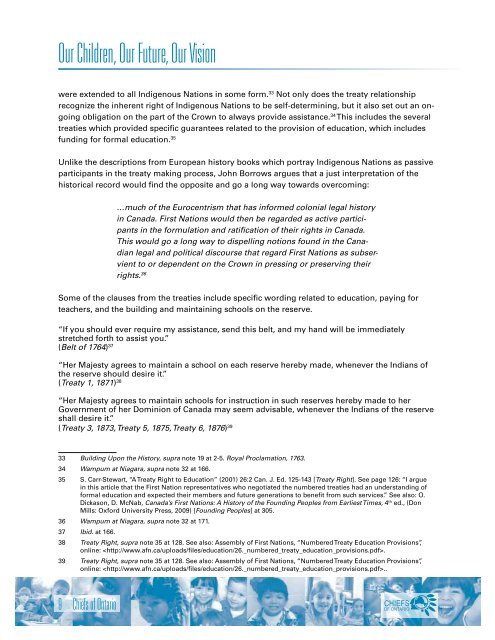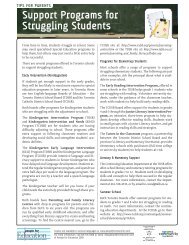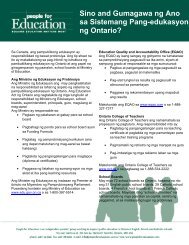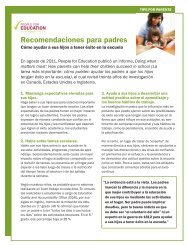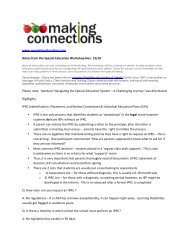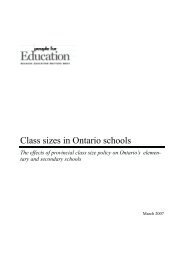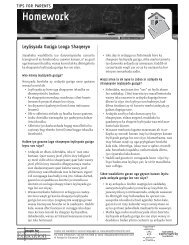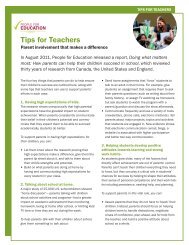Our Children Our Future Our Vision - People for Education
Our Children Our Future Our Vision - People for Education
Our Children Our Future Our Vision - People for Education
You also want an ePaper? Increase the reach of your titles
YUMPU automatically turns print PDFs into web optimized ePapers that Google loves.
<strong>Our</strong> <strong>Children</strong>, <strong>Our</strong> <strong>Future</strong>, <strong>Our</strong> <strong>Vision</strong><br />
were extended to all Indigenous Nations in some <strong>for</strong>m. 33 Not only does the treaty relationship<br />
recognize the inherent right of Indigenous Nations to be self-determining, but it also set out an ongoing<br />
obligation on the part of the Crown to always provide assistance. 34 This includes the several<br />
treaties which provided specific guarantees related to the provision of education, which includes<br />
funding <strong>for</strong> <strong>for</strong>mal education. 35<br />
Unlike the descriptions from European history books which portray Indigenous Nations as passive<br />
participants in the treaty making process, John Borrows argues that a just interpretation of the<br />
historical record would find the opposite and go a long way towards overcoming:<br />
…much of the Eurocentrism that has in<strong>for</strong>med colonial legal history<br />
in Canada. First Nations would then be regarded as active participants<br />
in the <strong>for</strong>mulation and ratification of their rights in Canada.<br />
This would go a long way to dispelling notions found in the Canadian<br />
legal and political discourse that regard First Nations as subservient<br />
to or dependent on the Crown in pressing or preserving their<br />
rights. 36<br />
Some of the clauses from the treaties include specific wording related to education, paying <strong>for</strong><br />
teachers, and the building and maintaining schools on the reserve.<br />
“If you should ever require my assistance, send this belt, and my hand will be immediately<br />
stretched <strong>for</strong>th to assist you.”<br />
(Belt of 1764) 37<br />
“Her Majesty agrees to maintain a school on each reserve hereby made, whenever the Indians of<br />
the reserve should desire it.”<br />
(Treaty 1, 1871) 38<br />
“Her Majesty agrees to maintain schools <strong>for</strong> instruction in such reserves hereby made to her<br />
Government of her Dominion of Canada may seem advisable, whenever the Indians of the reserve<br />
shall desire it.”<br />
(Treaty 3, 1873, Treaty 5, 1875, Treaty 6, 1876) 39<br />
33 Building Upon the History, supra note 19 at 2-5. Royal Proclamation, 1763.<br />
34 Wampum at Niagara, supra note 32 at 166.<br />
35 S. Carr-Stewart, “A Treaty Right to <strong>Education</strong>” (2001) 26:2 Can. J. Ed. 125-143 [Treaty Right]. See page 126: “I argue<br />
in this article that the First Nation representatives who negotiated the numbered treaties had an understanding of<br />
<strong>for</strong>mal education and expected their members and future generations to benefit from such services.” See also: O.<br />
Dickason, D. McNab, Canada’s First Nations: A History of the Founding <strong>People</strong>s from Earliest Times, 4 th ed., (Don<br />
Mills: Ox<strong>for</strong>d University Press, 2009) [Founding <strong>People</strong>s] at 305.<br />
36 Wampum at Niagara, supra note 32 at 171.<br />
37 Ibid. at 166.<br />
38 Treaty Right, supra note 35 at 128. See also: Assembly of First Nations, “Numbered Treaty <strong>Education</strong> Provisions”,<br />
online: .<br />
39 Treaty Right, supra note 35 at 128. See also: Assembly of First Nations, “Numbered Treaty <strong>Education</strong> Provisions”,<br />
online: ..<br />
9 Chiefs of Ontario


